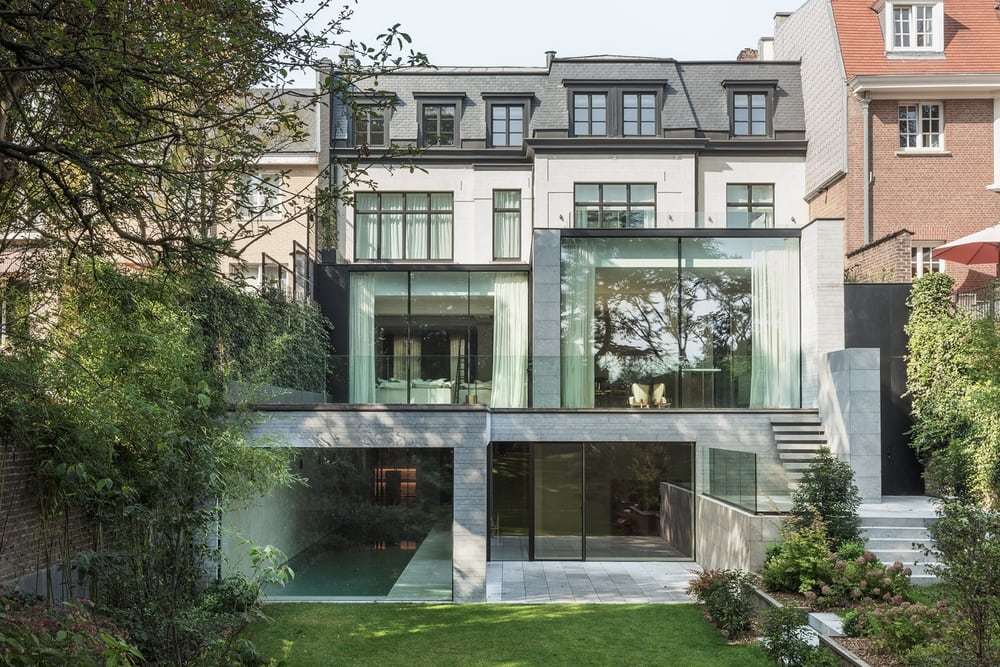Imagine a modern European home in 2050. Solar panels on every roof for local energy generation, state-of-the-art insulation maintaining electric heating or air conditioning for days at a time and energy-efficient appliances on every counter. A true smart house that interacts with the energy grid, autonomously optimising a family’s energy consumption for maximum efficiency. It runs energy-heavy appliances during the sunniest hours of the day, for example, and perhaps shuts the freezer off during the coldest hours of a winter night.
Instead of continuously ramping up energy production to meet the population’s ever-growing energy needs—a response businesspeople and politicians call demand-side solutions—this smart home would be instrumental in energy demand-side management: essentially, reducing energy consumption through smarter, more efficient management.
This is what European buildings could be like one day. There are “just” two problems: electrification and energy security. Today, about two-thirds of European energy consumption relies on imported oil and gas. To understand how we’ve gotten here, however, we’ll have to temporarily leave the future behind and dive over a century into the past.
“This energy system that we have is the result of choices that were made decades ago,” explains Thomas Pellerin-Carlin, a member of the European Parliament and shadow rapporteur for the parliament’s Security of Energy Supply in the EU’s own-initiative report. “The choice of fuels was made in the late 19th century, when Western Europe had access to a lot of fossil fuels: domestic coal and then eventually oil and gas. We had direct control of coal and gas because they were part of European empires.”
With decolonisation, Europe lost direct control over these resources but did not adapt its energy system accordingly. This made us reliant on other countries—a reliance that, in Pellerin-Carlin’s words, “started to bite us in 1973” when Arab members of the Organization of Petroleum Exporting Countries imposed oil embargoes against countries supporting Israel during the Yom Kippur War, nearly quadrupling the market price of oil barrels.
Learning from past energy choices
This first “oil shock” was a wake-up call for Western Europe’s need to accelerate energy diversification and lower our reliance on Middle Eastern oil imports. “We are paying now for choices made after 73,” Pellerin-Carlin explained. Some choices were positive, like regulating energy efficiency for the first time, and ramping up domestic energy production. But some of them, according to the MEP, were short-sighted, like building pipelines to buy Russian oil and gas—another reliance on foreign imports that led to an energy shock that worsened after Russia invaded Ukraine in 2022.
To emerge from this energy shock, Pellerin-Carlin argues that Europe needs to work toward two main goals: an intense reduction in energy demand, and a rapid increase in renewable and nuclear energy to replace oil and gas.
To that end, the European Climate Foundation, European Insulation Manufacturers Association (EURIMA) and the International Copper Association have recently commissioned a study called “Flattening the Peak Demand Curve through Energy Efficient Buildings: A Holistic Approach Towards Net-Zero Carbon.” In the study, researchers developed a model of Europe’s energy system cost, with which they can simulate various scenarios reflecting the implementation of different energy measures.
Using this model, the researchers demonstrate that a combination of measures—such as energy-efficient buildings, improved grid flexibility and smarter demand-side management—could significantly lower energy costs, stabilise the power grid and accelerate the EU’s climate goals.
“What is new with the report is that it's not looking only at one aspect of the problem like electricity transmission or solar energy for residential buildings or implementing more heat pumps. It's looking at the overall system effect,” said David Ducarme, Deputy CEO Knauf Insulation, a member of EURIMA. “What makes it very attractive for many is to finally have concrete numbers about the full system cost.”
The report’s conclusions align with Pellerin-Carlin’s stance on the need for a reduction in energy demand, and focus specifically on the so-called peak energy demand. Peak energy demand is that time of the day when energy consumption skyrockets—when everyone returns home from work, turns on all the lights, heats or cools their home, cooks dinner, does laundry… you get the point. These moments see the greatest strain on energy transmission lines, which sometimes lead to blackouts.
The potential of modern energy-efficient buildings
That’s where a fully electrified, perfectly insulated and digitalised building able to consume and one day manage energy efficiently, like the one described at the beginning of this article, would come in handy—especially as the much-needed transition to renewable energies will continue to grow the demand for electricity. But the good news is that modern buildings are already making steps in that direction.
“The buildings that are built now are great, they’re super energy efficient,” Pellerin-Carlin explained. “The big challenge has to do with renovating older buildings.”
Despite the Green Deal’s 2020 Renovation Wave Strategy, which aimed to at least double energy renovation rates by 2030, in 2023 the rate was still around 1 percent. To ultimately align with the EU’s carbon-neutral goal and decarbonise all buildings by 2050, the renovation rate needs to be over 2 percent, according to the International Energy Agency.
In fact, the report highlights widespread building renovations as a vital aspect of creating a resilient, decarbonised, efficient, cheaper and more competitive energy system. For example, expanding energy efficiency renovation measures, enhancing system flexibility and accelerating the adoption of heat pumps across the EU could cut peak heating demand by almost 50 percent by 2050, compared to continuing with the current pace of renovations.
This would reduce total energy system costs by €312 billion annually and cut distribution grid investment (money spent to expand and improve the infrastructure that delivers electricity to buildings) by €44,2 billion per year. On the green transition front, the report also demonstrates that widespread building renovation would lower greenhouse gas emissions by 10 percent more than current 2030 targets, support a faster phasing out of coal and gas use and ease the pressure on renewable energy infrastructure, thus achieving the EU’s carbon neutral 2050 goal with fewer investments.
More broadly, the report provides technical backing for the EU’s Fit for 55 package (EU’s strategy to reduce greenhouse gas emissions by 55% by 2030), which includes the Energy Performance of Buildings Directive (a legislative tool that sets energy performance standards, mandates renovations and phases out fossil fuels in buildings).
“The message that I would like to put forward is that we have finished the Fit for 55 package at the European Level as important regulatory framework to provide visibility, stability and predictability for enabling European construction and energy efficiency businesses that stand ready to make it happen. This package now needs to be implemented at the member state level,” said Jan te Bos, Director General of Eurima.
In practice, the implementation of such widespread energy efficiency measures is going to ask for recognition of the fact that we are in an “and-and-and” situation, and not an “either-or;” it is “one big project management challenge,” he summarised. “The next step is to go to a system based on ‘help-me-don’t-tell-me’ involving all relevant players to deliver this crucial project for the EU and its citizens. And that’s the reason why we commissioned this study, to show how the different parts of the puzzle—that had already been identified under the Green Deal and way before that—all fit together.”
Ultimately, te Bos concluded, “The access to large amounts of green electricity is at the centre for Europe to redefine its place in a volatile geo-political context; energy efficiency in buildings is at the heart of how we want to organise things.”

